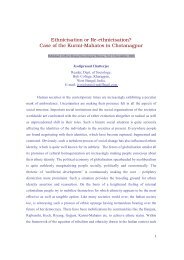"The Cruel Striker War" - NIU Digital Projects
"The Cruel Striker War" - NIU Digital Projects
"The Cruel Striker War" - NIU Digital Projects
Create successful ePaper yourself
Turn your PDF publications into a flip-book with our unique Google optimized e-Paper software.
local cigarmakers and pipefitters had organized, rail labor provided<br />
the mainstay of the local labor movement, particularly after the<br />
Sante Fe Railroad extended a line through the town. During the<br />
1877 strike, the BLE had organized participants "into different<br />
parties, representing the different classes of railroad employees,"<br />
probably sowing the seeds for the new locals of firemen,<br />
conductors and brakemen. 27<br />
By 1885, the formation in Galesburg of the Knox and<br />
Bennet Assemblies of the Knights of Labor most concerned the<br />
CB&Q. Although these "mixed" assemblies recruited "producers"<br />
of various occupations, the order's recent strikes on the railroads<br />
made it particularly attractive for workers in that industry<br />
unprotected by the craft brotherhoods. <strong>The</strong> CB&Q management<br />
blacklisted the Knights, but its informers reported that "young men<br />
barely out of their apprenticeship have been decoyed into it, as well<br />
as some of our apprentices." Railroad officials consoled<br />
themselves that few skilled workers in their industry participated,<br />
and that railroaders in general supplied only 150 of the estimated<br />
Galesburg membership of about 400 Knights. 28<br />
Galesburg had reacted to the strike of 1877 and its aftermath<br />
as a self-governing small town rather than as a locally-managing<br />
component of a much larger and expanding corporate order. By the<br />
standards of the railroad, however, the town had failed to defend<br />
the prerogatives of corporate power. 1888 brought the community<br />
another, definitive challenge.<br />
III<br />
<strong>The</strong> CB&Q strike of 1888 revealed the new status of<br />
working class citizenship. Workers long resented the railroad's<br />
method of computing wages for work over the road, believing that<br />
it cheapened both their identity in the community and the stability<br />
of their families. <strong>The</strong> BLE and Brotherhood of Locomotive<br />
Firemen responded to management's refusal to negotiate with a<br />
strike call on February 27, 1888. Members now told each other that<br />
94

















